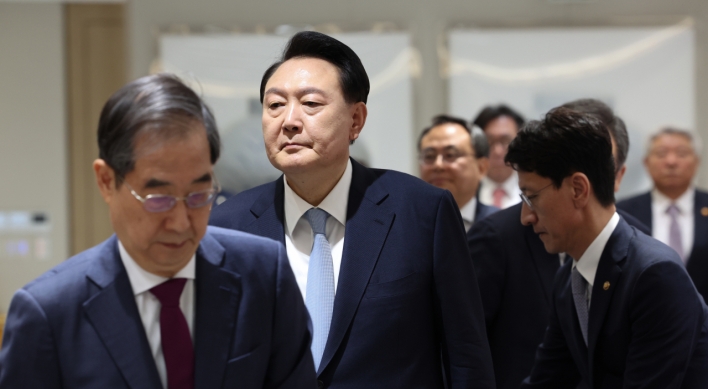[From the Scene] Drones the highlight of DX Korea defense expo
Hyundai, Hanwha, LIG Nex1, KAI offer glimpse into unmanned combat technologies at Korea’s biggest land weapons expo
By Kim Byung-wookPublished : Nov. 24, 2020 - 17:00

GOYANG, Gyeonggi Province -- From Iraqi commander to Filipino admiral, the 4,000-square-meter hall was packed with high-ranking military officials wandering around some 200 booths where state-of-the-art weapons and systems were displayed by global defense companies from about 20 countries around the world.
At DX Korea 2020 -- a military expo held at Kintex in Goyang, Gyeonggi Province, just northwest of Seoul, on Nov. 18 -- Korean Army officials were greeted by public relations officials, ready to rock and roll with their well-crafted sales pitches.
Due to social-distancing measures, handshakes have been replaced by the simple exchange of business cards.
Obviously, the ongoing coronavirus outbreak has changed the trends and paradigm in different industries, and the defense industry was no exception. At this year’s DX Korea, the main theme was “unmanned” weapons and systems.
As always, the expo brought together old rivals and friends. Among them, the tension between Hyundai Rotem and Hanwha Defense was palpable in the air, as both firms were contending for the Army’s fast-track project to procure multipurpose unmanned ground vehicles that can conduct search, reconnaissance, transport and fire support missions.
But due to the technical issue raised by the military, Hyundai Rotem’s HR-Sherpa became the only MUGV to participate in the demonstration. Hyundai Rotem controlled the HR-Sherpa via a Wi-Fi connection.
At DX Korea 2020 -- a military expo held at Kintex in Goyang, Gyeonggi Province, just northwest of Seoul, on Nov. 18 -- Korean Army officials were greeted by public relations officials, ready to rock and roll with their well-crafted sales pitches.
Due to social-distancing measures, handshakes have been replaced by the simple exchange of business cards.
Obviously, the ongoing coronavirus outbreak has changed the trends and paradigm in different industries, and the defense industry was no exception. At this year’s DX Korea, the main theme was “unmanned” weapons and systems.
As always, the expo brought together old rivals and friends. Among them, the tension between Hyundai Rotem and Hanwha Defense was palpable in the air, as both firms were contending for the Army’s fast-track project to procure multipurpose unmanned ground vehicles that can conduct search, reconnaissance, transport and fire support missions.
But due to the technical issue raised by the military, Hyundai Rotem’s HR-Sherpa became the only MUGV to participate in the demonstration. Hyundai Rotem controlled the HR-Sherpa via a Wi-Fi connection.

“Hanwha was told by the military not to demonstrate its MUGV because a radio frequency linking the prototype and the remote control might cause wave interference with drones during the event,” said the company official, adding that its prototype worked just fine.
Despite the publicity the military has given to Hyundai Rotem’s HR-Sherpa, Hanwha Defense’s MUGV also showed its significance in multiple categories.
In terms of weight, Hanwha Defense’s MUGV’s curb weight is less than 1 metric ton and its armed weight is 1.7 tons, compared to the HR-Sherpa’s 1.6 tons and 2 tons.
“Thanks to the light weight, Hanwha Defense’s MUGV’s can be carried by Surion, Korea’s military chopper,” the company official said.
In terms of speed, the Hanwha MUGV took the lead with maximum speed of 40 kilometers per hour on paved roads and 18 kph compared to the HR-Sherpa’s 30 kph and 15 kph. The Hanwha MUGV has also a driving range of 200 kilometers compared to the HR-Sherpa’s 30 kilometers. Both use lithium-ion batteries.
The remote control range of Hanwha MUGV is 1.6 kilometers, compared to the HR-Sherpa’s 1 kilometer. With the help of a communication drone, Hanwha can increase the range two to three times.
Hanwha Defense and Hyundai Rotem submitted the bid prices for each of their vehicles on Nov. 17. On Nov. 19, the military decided to procure Hyundai Rotem’s HR-Sherpa.
“Which model the military picks will dictate each company’s export plans, as foreign buyers will require a track record on the MUGVs,” an industry source said.
Though Hanwha Defense lost the bid, it won a deal worth 18 billion won ($16.2 million) Tuesday to supply a bomb detection robot that can sniff out improvised explosive devices and mines by 2023.

If Hanwha Defense was engaged in a battle with Hyundai Rotem on the ground, a drone battle was unfolding in the air between Hanwha Systems and LIG Nex1.
Sharing the same booth with Hanwha Defense, Hanwha Systems -- a defense and information technology service unit of Hanwha Group -- featured a mock-up of its air vehicle Butterfly, one-third of its actual size, at the center of the stage.
“Butterfly, which is under development with US air taxi startup Overair, is expected to cost between 1 billion won and 2 billion won. Capable of rapid charging, the urban air mobility can travel from Seoul to Incheon within 20 minutes. Powered 100 percent by batteries, Butterfly is equipped with a vertical takeoff function and a low-noise technology,” a Hanwha Systems official said.
Though the Butterfly was stealing the show, the real deal was displayed at the far back of the booth: the drone.

Hanwha Systems’ “smart loitering munition drone system” consists of a drone with four wings that can hover in the sky for 1 hour. Hanwha Systems aims to deploy the drone by 2026 at a price of 100 million won, which is half the price of drones developed by other countries such as Israel, according to a Hanwha Systems official.
Meanwhile, at the booth of aerospace and defense company LIG Nex1, a “loitering munition” drone was hanging from the ceiling with a completely different design. Comprising two propellers and two tails, the drone resembled a twin-boom aircraft, though much smaller in size.

Asked if the drone was designed for assault, an LIG Nex1 official said that the drone was intended for reconnaissance and surveillance missions.
Korea Aerospace Industries, South Korea’s sole aircraft developer, for its part, unveiled a combined combat system that integrates manned helicopters with drones.
“KAI is devising a combined combat system in which a pilot inside a light armed helicopter can deploy drones. Then, these drones will accompany the manned helicopter at both sides,” a KAI official said.
“For rescue missions, a pilot inside the Surion chopper, for instance, will be able to send out a swarm of drones from the chopper to search the location of the target.”
KAI is not likely to develop the drones independently, but rather collaborate with already established drone companies. The drones shown in the concept video of KAI’s combined combat system featured designs more similar to LIG Nex1’s twin-boom drones.

KAI also displayed an actual prototype of its unmanned chopper Night Intruder, which conducts an autonomous vertical takeoff and landing both on land or ship.
Night Intruder completed an unmanned test flight in September last year. With a maximum takeoff weight of 600 kilograms, Night Intruder can hover in the air up to six hours.
By Kim Byung-wook (kbw@heraldcorp.com)









![[KH Explains] How should Korea adjust its trade defenses against Chinese EVs?](http://res.heraldm.com/phpwas/restmb_idxmake.php?idx=644&simg=/content/image/2024/04/15/20240415050562_0.jpg&u=20240415144419)









